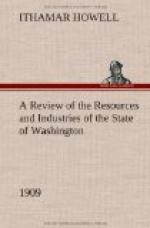There are, however, some high grade ores in narrow fissures and in a few localities free milling ores and placer deposits are found. In most cases the free milling ores are the result of oxidation and will be found to be base as water level is reached in the mining process.
Mining of precious metals is being prosecuted in Whatcom, Skagit, Snohomish, King, Pierce, Lewis, Skamania, Cowlitz, Okanogan, Chelan, Kittitas, Yakima, Klickitat, Ferry and Stevens counties.
Of the metals the mines of the state are producing gold, silver, lead, copper, quicksilver, zinc, arsenic, antimony, molybdenum, [Page 12] nickel, cobalt, tungsten, titanium, bismuth, sulphur, selenium, tellurium, tin and platinum.
There are also iron mines, and quarries of marble, granite, onyx, serpentine, limestone and sandstone—beds of fire clay, kaolin, fire and potter’s clays, talc and asbestos and many prospects of petroleum.
Mining is suffering for the lack of transportation for the low grade ores, but prospects are excellent for relief in this regard in the near future. The era of wildcat exploitation has been relegated to the past and legitimate mining is now getting a firmer hold in the state, and we look for results within the next five years which will astonish many who think themselves well informed.
FISHERIES.
A glance at the map of the state will disclose a remarkable combination of salt and fresh waters within the jurisdiction of the state of such a character as to amaze one not familiar with it, but learned in the habits of the finny tribe in general.
The ocean is the great feeding ground. Out of its mysterious depths the millions of fish come into fresh waters fat and rich from the salt water vegetation.
[Illustration: Plate No. 9.—Chelan County Views.]
[Illustration: Plate No. 10.—Farm and Dairy Scene Common to Clallam County.]
The great Columbia river in the south, Willapa harbor, Grays harbor, the majestic straits of Fuca and the equally majestic straits of Georgia on the north are all great open highways from the sea, not only for merchandise laden ships, but for myriads of salt water food fishes which annually traverse their bottoms. Into these open mouths flows a great network of fresh water rivers and streams, draining the entire area of the state and providing the spawning waters for the fishes from the sea not only, but for millions of strictly fresh water fishes. Not only these, but late years have proven the shore waters of the state to produce also great numbers of oysters, clams, crabs and shrimp. Nor is this all, because the proximity of the state to the ocean gives it a great advantage in profiting from the fishing industry among that class of the finny hosts who refuse to leave their salt water homes. So that from the whales of Bering sea to the speckled beauties that haunt the mountain [Page 13] streams, through the long list of delectable salt and fresh water food, the fisherman of Washington has an enticing and most profitable chance to satisfy his love of sport and adventure not only, but to increase his bank account as well.




